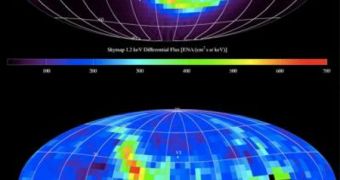The Interstellar Boundary Explorer (IBEX) mission that NASA ran a few years ago was one of the most interesting ones in terms of discoveries. The experts handling the instrument managed to compile and create one of the most detailed maps of the edge of our solar system, but in particles. This allowed researchers to observe that a narrow ribbon of bright particles appeared at the location, which was a phenomenon unexplained by models at the time. Now, some experts are trying to replicate the IBEX findings, using the magnetic mirror effect.
They say that, while, indeed, the particle ribbon was not predicted by models, or even hinted at in preliminary IBEX studies, its existence can be easily explained if a single factor is added into existing simulations. Experts working under NASA's Heliophysics Guest Investigator program determined that the local galactic magnetic field – the magnetic field that surrounds the solar system – had to be acting like a mirror for the particles the IBEX detected. Adding this effect into models finally allowed solar physicists to make sense of the spacecraft's observations.
The same science team that came to this conclusion also believes that the orientation of the magnetic field is also a decisive factor in determining the position that the ribbon of bright particles takes up on the sky. The work was conducted by a group at the University of Alabama in Huntsville that was led by expert Jacob Heerikhuisen. He is also the lead author of a new paper detailing the findings, which appears in the January 10 issue of the respected Astrophysical Journal Letters.
“The IBEX mission has from the outset stressed both the criticality of new measurements and the collaboration between observations and theoretical research. The discovery by Heerikhuisen and colleagues demonstrates how successful this approach can be,” IBEX mission scientist Robert MacDowal explains. He is based at the NASA Goddard Space Flight Center, in Greenbelt, Maryland. The new work also reveals that the magnetic fields in the local interstellar medium (LISM) are stronger than initially thought, which is a conclusion first hinted at by the Voyager instruments.
“By activating IBEX, we suddenly see that the solar system has a lit candle and see its light reflected in the 'cave walls' shining back at us. What we find is that the 'cave wall' acts more like a faint mirror than like a normal wall,” NASA Headquarters IBEX program scientist Arik Posner says. Additionally, the instrument appears to be viewing particles that come from before and behind the heliopause (as viewed from the Earth). This area is the delimitation between our solar system and the surrounding galactic medium.

 14 DAY TRIAL //
14 DAY TRIAL //